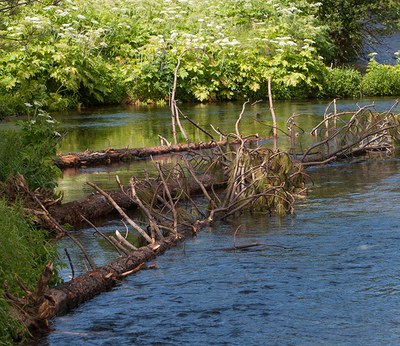
For decades, removal of trees and snags (dead standing trees) in rivers and streams was seen as a helpful process; one that would clear waterways and provide more favorable navigation conditions for recreation and transport. Removal of downed logs was also considered an improvement to the beauty of a stream, and was driven by thoughts of property protection and flood control.
Over time, research has shown that removal of large woody debris from streams and creeks has been detrimental to fish populations. Including woody debris into stream restoration design is essential to improving the health and structure of Whychus Creek.
So what exactly does woody debris do in natural systems? Here are seven ecological functions of woody debris in rivers, creeks and streams, from Hannah Ettema and the National Forest Foundation:
1. Large woody debris helps slow the flow of water, making it easier for adult fish to move upstream and for juveniles to rear. This in turn helps them expend less of their limited and valuable energy fighting strong currents. In restoration projects, large woody debris is also often spread across the floodplain to help slow water and reduce erosion during high water events.
2. Gravel is an important material for salmon and steelhead to build redds and lay eggs. Adding wood debris to streams helps slow water flow allowing larger sediment like gravel to fall to the streambed instead of continuing downstream.
3. Large woody debris can help decrease water temperature by providing shaded areas along streams and creating pockets of cooler water for cold-water loving species.
4. Large woody debris creates places for fish to hide and seek refuge from predators.
5. Woody debris helps trap organic material like leaves and twigs that provide nutrients for insects and invertebrates (critters without spines), which in turn provide food for fish.
6. Large woody debris helps streambanks by preventing erosion of soil along banks.
7. Pools of water and “steps” created by woody debris can also provide habitat for fish during periods of low water flow.
Learn more:
- Dig deep on large woody debris.
- Learn more about the multi-year Whychus Creek restoration.


